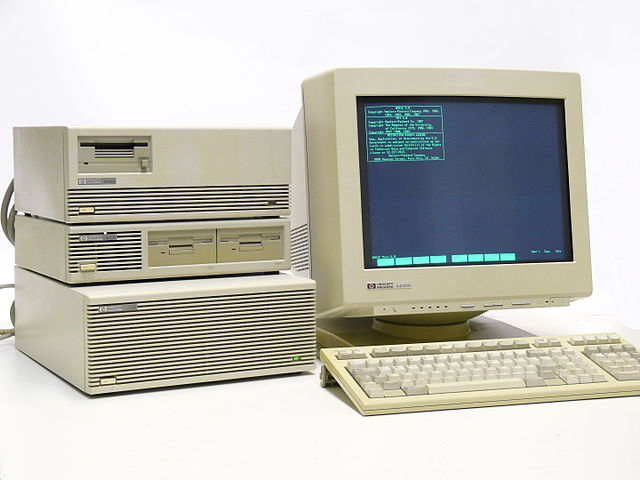hp-series300.netHP 9000 series 300 vintage computers
Introduction
Hewlett-Packard's 9000 Series 300 (HP300) was a range of technical workstations based on Motorola 680x0 microprocessors. Superbly engineered in modular form, and ahead of the curve in terms of functionality, these workstations were used mainly as instrument controllers and for desktop technical computing. The HP300 series launched in 1985 with the models 310 (pictured below) and 320. It evolved through numerous variants of increasing power, concluding with the 38x models released in 1991. The series was officially obsolete as of 1997.

Photo credit: Thomas Schanz (Wikimedia Commons)
The definitive website dedicated to vintage Hewlett-Packard computers is the wonderful HP Computer Museum, which has excellent and wide-ranging archival resources. The present site is focused specifically on the HP 9000 series 300 and is for anyone interested in the history, conservation and restoration of these personal workstations.
Genesis of the HP300 Series
HP produced some of the very earliest desktop computers in the mid-1970s with its 98x5 range, including the 9825, 9835 and the amazing 9845. These were all based on custom CPUs developed by HP. Thereafter, HP followed a twin track: continuing to develop its own processors (FOCUS and later PA-RISC), but also developing a strong product line based on the Motorola 680x0 series microprocessors. The HP300 series belongs to that development branch as shown in the figure below.

Applications
Instrument Control
HP300 computers were ideally suited to instrument control applications and were indeed developed partly to support HP’s extensive range of test and measurement instruments. The built-in HP-IB interface provided an extremely robust and, for the time, fast means of transferring commands and data between a series 300 controller and a wide range of instruments. Serial interfaces (either the built-in RS-232 or the optional DataComm interface) gave access to many others.
The USP for HP300 computer-controllers was actually the software: HP BASIC/WS. This combined operating system and programming language provided both power and simplicity, elevating the language above its competitors. Known as Rocky Mountain Basic (RMB), in recognition of its Colorado roots, RMB made sophisticated scientific and engineering computing easy by providing advanced features such as built-in matrix and complex arithmetic functions and a useful range of graphics capabilities. Two simple commands (OUTPUT and ENTER) permitted data to be sent to or read back from devices connected to any of the computer’s interfaces. Moreover, event-initiated branching allowed sections of the code to be executed in response to specific events such as a software timer, a key press or a service request from a connected instrument. These attributes made programming instrument control sequences, data acquisition and data processing quick, easy and intuitive; and they enabled the HP300 series to command a premium price in the instrument control market.
Computer-Aided Engineering and Scientific Computing
HP combined 300-series hardware with the HP-UX operating system to provide a powerful personal platform for proprietary computer-aided engineering applications including computer-aided mechanical and electronic design. The availability of custom graphics frame buffers, hardware accelerators, and the Starbase software library provided 2- and 3-D graphics capabilities, including solid rendering, ahead of most rivals. Additionally, scientific programming languages such as ANSI C, C++ and Fortran were available under HP-UX. Users could write their own code and compile third-party source code into their own applications. With HP-UX, series 300 computers could also support multiple users and serve the needs of business and commercial users.
Beyond the 300 Series
The development of the 300 series was most likely terminated in response to two factors. First, Motorola lost the "MHz race" and its range of 680x0 processors was rapidly overtaken by rivals. Second, HP had invested heavily in developing its own PA-RISC processor series which powered the 700 series and subsequent generations of workstations and servers developed throughout the 1990s.